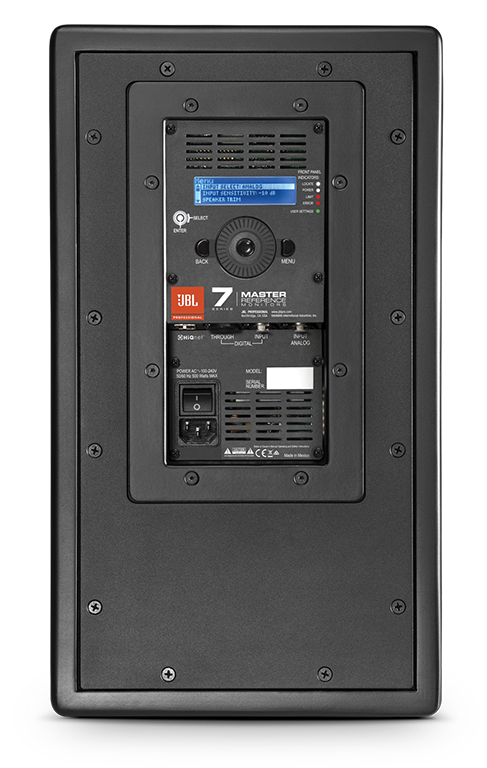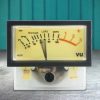
Review: JBL 7 Series Studio Monitors
Past and future collide with JBL’s 7 series, combining super-wide, pillowy wave guides with all manner of digital connectivity.
JBL, or more succinctly, Mr James B. Lansing, has been trotting out sound reinforcement drivers for the motion picture industry since the 1920s; the musical instrument field with Fender’s use of the D130F speaker for its instrument amplifiers since the late 1950s; and for the professional studio sphere since 1973 with the 4300 series studio monitors. The company’s been around several blocks multiple times, and these days, JBL has pretty much become a household name.
But JBL didn’t start out as JBL. The company’s founder, James B. Lansing, kicked it all off in 1927 with the Lansing Manufacturing Company. In 1941, the Lansing Manufacturing Company was acquired by Altec Service Company, hence Altec Lansing. It wasn’t until James Lansing left Altec Lansing to form a company using his initials that JBL was born.
Long story short; JBL has been in the monitoring game far longer than most. The company knows its schtick. Not being a manufacturer to rest upon its laurels, virtually each year or so there’s another instalment to its studio monitoring lineage. Most recently, and sitting on my monitor bridge is a pair of the JBL 7 series — the 708P to be precise — the daddy of the outfit. The series offers four flavours. Either the 705i and 708i with five-inch or eight-inch drivers in an unpowered format with no DSP, or the 705P and 708P five- and eight-inch biamped models, sporting digital I/O and user adjustable DSP. Before we get too deeply involved with the DSP and amplification we’ll have a look at the drivers and cabinet design from the vantage point of the 708P.
PHANTOM SPECS
Cabinet-wise the 708P is a largish box measuring 438 x 248 x 292mm. They’re surprising light, weighing in at 11.5kg. Unique to the 708P cabinet are recessed handles either side of the cabinet, which seem a little like overkill for such a light monitor. Handy for pulling them out of the boxes though. There’s no indication of the cabinet material other than “birch plywood reinforced for mounting”, which you could interpret as ply reinforcement for the top and bottom four-screw mounting points in what is otherwise a box made of MDF material. What the listener sees and feels is arguably more important, which is a smooth black surface with a moulded plastic waveguide and metal grille covering the woofer.
The specs indicate a four-hole mounting point system on the rear of the 708P, however I couldn’t see anything rearward for mounting duties. There seems to be a few discrepancies with the published website images and the monitors in the flesh, as the website shows phillips-head screws while the actual monitor uses hex-head fasteners throughout. Maybe this explains the phantom rear-mount points.
NEED TO KNOW

When it comes to I/O the 708P is about as featured as a monitor gets. The rear of the 708P houses a typical XLR analogue input, but there’s also an XLR AES3 digital input and an XLR pass-through output. Sample rates can be anything up to 192kHz, including obscure clock-speeds, as the DSP incorporates sample-rate conversion. A Harman HiQnet port enables feature updates and interfacing with control systems such as HiQnet AudioArchitect. HiQnet is compliant with Dante protocol so you can integrate the 708P into networked systems.
WIDE & WAVEY
The design incorporates a lower front port placed below the low-frequency driver and upper wave-guide around the high-end driver. Both the port and waveguide are part of the entire front baffle — an extruded single piece of plastic. JBL have introduced yet another high-frequency waveguide in the 7 Series — the ‘Image Control Waveguide’, which of course has a patent application pending. It’s a dramatic departure from waveguides designed by the company in the past such as the LSR series and even my old 4200 series monitors. This waveguide is quite large, taking up the entire width of the 708P, reminding me of ancient Altec-Lansing horn designs. It’s virtually identical to the waveguide used on the M2 mastering series. JBL says the waveguide provides an ‘acoustically seamless transition between the woofer and high-frequency transducer’ and it certainly seems to live up to this claim. The waveguide also aids spreading of the on- and off-axis frequency response, enabling a wider listening area.
As for the drivers, JBL has employed an entirely next-gen design for both the low and high frequency drivers. The high-frequency drivers low-mass annular diaphragm offers a frequency response beyond 36kHz. Annular diaphragms allow for extremely high output and very low distortion. It’s certainly evident with the 708P high-end 2409H driver, and driven by a discreet 250W class-D amplifier it pushes out some high pressure levels.
Driven again by a 250W Class D amp is the newly designed 728G low-frequency driver which uses differential drive technology to provide low-frequency performance down to 35Hz. JBL claims the 708P can deliver two to three times the output of other monitors, with 114dB SPL (peak) at one metre. Trust me, they’re loud. They’re also remarkably clean and lacking in distortion, although I’ve still not found any published distortion specifications. Overall frequency response is quoted as -1.5dB from 45Hz through to 23kHz (overall response apparently 35Hz – 36kHz), with the DSP-based crossover network set at 1.7kHz.
HIGH DIGITAL HIQ
When it comes to I/O the 708P is about as featured as a monitor gets. The rear of the 708P houses a typical XLR analogue input, but there’s also an XLR AES3 digital input and an XLR pass-through output. Sample rates can be anything up to 192kHz, including obscure clock-speeds, as the DSP incorporates sample-rate conversion. A Harman HiQnet port alongside the AES XLR ports enables feature updates as they become available. As well as interfacing with control systems such as HiQnet AudioArchitect, HiQnet is compliant with Dante protocol so you can integrate the 708P into networked systems.
But what’s to update? Well there’s actually quite a lot. Being DSP-based there’s a tonne of EQ and delay settings. The 708P features onboard room equalisation for compensation of room acoustics. In addition to 12 bands of room EQ, there are eight bands of user EQ so users can customise response curves to compensate for placements behind cinema screens and the like. Once dialled in, there are six memory locations for storing said EQ setups. There’s also user-enabled delay for virtual alignment of speakers relative to the listening position and what JBL term ‘AV Synchronization’ delay to compensate for latency in video displays.
Adjustment of all DSP features is via a simple scroll wheel, a couple of menu buttons and a small backlit LCD on the rear of the 708P. While this arrangement gets the job done it does feel a little under-engineered. The buttons feel as if they’ll fail if you use them too much.
Cutting a long story short, and considering the 708P has pretty much any connectivity feature you could require, the question remains about how the 708P sounds. In a stereo setting they’re a very analytical monitor, and no doubt due to JBL’s next-generation drivers are both loud and startlingly accurate. The low-end is remarkably tight and succinct, while the top-end is staggeringly detailed. Personally, I find JBL monitors to be a little fatiguing, primarily due to the company’s allegiance to titanium or other metal dome tweeters; but these are far less so. I spent quite some time in front of the 708Ps without feeling the need to tone it down for a while. Far from flattering, they’re an accurate, loud, and capable monitor.




























RESPONSES